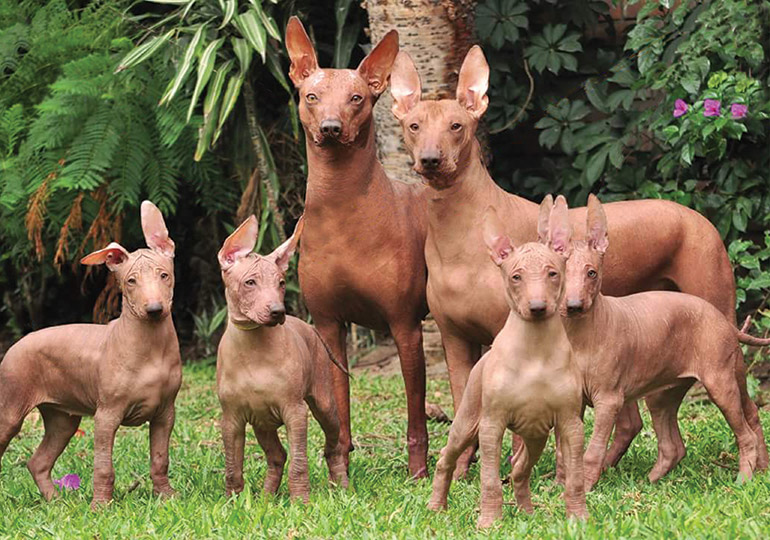Breeds
Peruvian Hairless Dog (Small, Medium, Large)

GROUP 4 - HOUNDS
History
There are many written articles regarding the origins of the Peruvian Hairless Dog, but, “according to certain experts, this dog was introduced to Peru during the Chinese immigration, soon after the promulgation of the law abolishing the slavery of blacks by the President of Peru. On the other hand, other researchers suppose that this dog comes from the African continent through the intermediary of nomads, wo arrived in America accompanied by their hairless dogs.” 1.
In Peru, and also common with many cultures, domestic dogs served not only as companion animals, but also contributed to the daily tasks undertaken by humankind. They watched over herds, participated in the hunt and guarded homes.
From time to time, according to legend, a hairless dog was born the colour of copper (most were normally black or slate grey), which was seen as a good omen and a sign of improving fortunes for the community. In this instance, such dogs were sacrificed by society and given as offerings to the Gods, up until the time when a local chieftain came across a young boy hiding with a copper puppy in his arms. On seeing how defenceless the boy and his dog were, the Chieftain was moved to compassion and decided to save the lives of all copper-coloured dogs, decreeing that dogs the colour of the sun would be
known as a ‘Child of the Sun God’ and reared in his palaces as privileged creatures. When an individual was permitted to approach the golden dog, they had to do so barefoot and carrying a symbolic load on their back (as a sign of submission), were not permitted to look into his eyes.
These beautiful animals were also immortalised by pottery makers and found in the tombs of the ruling elite and nobility of ancient Peru.
It has been verified that the internal and external temperature of these dogs is exactly the same as that of other breeds. In the colder regions of ancient Peru, the Peruvian Hairless Dog was used as a natural way of warming the owners bed and also used in medical practices. It was believed that contact with the dog relieved the symptoms of rheumatism or arthritis. These dogs served as a kind of living hot water bottle.
Appearance
General appearance is of an elegant and slim dog, whose aspect expresses speed, strength and harmony without ever appearing coarse.
The skin should be smooth and elastic all over the body but can form a few rounded almost concentric lines on the head and round the eyes and cheeks.
There are 3 sizes acceptable in the Breed – Small being from 25 to 40cms (4 – 8 kgs) Medium from 40 to 50cms (8 to 12 kgs) and Large from 50 to 65 cms (12 to 25kgs)
Their colour can vary from black, slate black, elephant black, bluish black, the whole scale of greys, dark brown going to light blonde. They can also show pinkish patches at all points of the body. A fully coated variety of the breed is also acceptable.” 3.
Temperament & Suitability
“Noble and affectionate at home with those close to him, at the same time lively and alert; he might be wary of strangers and a good watch dog.” 4. This breed can be very shy at first and needs time to trust new people and things. Approach the dog with a no-nonsense attitude and pat him, if you approach slowly with hands out, the dog assumes the worst and backs away.
Care
“The lack of hair leads to a reputation for being clean, for being easy to wash with a sponge, and for a natural lack of fleas or other parasites. They also do not cause typical allergic reactions to dog-sensitive humans because they lack the normal dog dander. The skin should be washed from time to time to remove dirt and prevent clogging of pores. Baby cleaners are a good choice provided that they do not contain lanolin. Some dogs are prone to have acne or at least blackheads. The skin sometimes becomes too dry and can then be treated with moisturising cream. Again, baby lotion without lanolin is a good product choice to soften and moisturise cleansed skin. The dogs themselves seem to prefer olive, vegetable or coconut oil, possibly because of
the perfumes and other chemicals found in commercial moisturising creams.
Protection against sunlight is recommended on lightly colored dogs. Sun-block or other methods are beneficial to prevent sunburn. Protection against cold is necessary, however, sensitivity to cold may vary from dog to dog. Smaller dogs seem to be more sensitive to the cold than their larger counterparts. The rims of the ears sometimes need special attention as they can become dry and cracked.” 5.
Health
“The gene that causes hairlessness also results in the breed often having fewer teeth than other breeds, mostly lacking molarsand premolars. All are born with full sets of puppy teeth, but these are not fully replaced by adult teeth, as they naturally fall out, leaving them with varying levels of adult dentition.
Like all breeds there are some health problems, which can include IBD, seizures, stroke and skin lesions. They are verysensitive to toxins and care should be taken in use of insecticides. Insecticides are absorbed through the skin and body fat keeps these toxins from entering the liver too quickly. Since these dogs have very low body fat, toxins are absorbed too quickly and cause severe damage to the nervous system and GI tract.” 6.
Words: Joy Lanham
References
Ref: 1 to 6 - Source: Dogs Australia (small) (medium) (large)
Wikipedia.org
Image supplied by Joy Lanham
In Conclusion
Now you know a little about the Peruvian Hairless Dog you may have think that this is the dog for you. Before you make a decision, please make contact with the breed club or your State controlling body for purebred dogs. They will be able to give you information about available puppies and also suggest dog shows where you can see the breed and speak to breeders. In this way you will gain a better perspective of the Peruvian Hairless dog and its needs and whether this breed would suit your lifestyle.
Breeders
Sorry, there are currently no breeders advertising for this breed. If you are a registered Dogs SA breeder and wish to advertise here please create an advertisement here.

